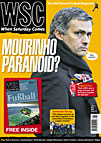 The death of Jimmy Johnstone has provoked the usual reminiscences about an outstanding individual but also a wider debate, as Dianne Millen explains
The death of Jimmy Johnstone has provoked the usual reminiscences about an outstanding individual but also a wider debate, as Dianne Millen explains
Celtic and Scotland legend Jimmy Johnstone, who scored more than a hundred goals for the Hoops and was capped 23 times, passed away on Monday March 13 aged 61. He had suffered from motor neurone disease for almost five years. Nicknamed “Jinky” by Celtic fans in recognition of his mercurial wing play, he was best known as a member of the “Lisbon Lions” team, the first British side to win the European Cup, and was also part of the side that captured nine consecutive Scottish League titles.
Special as that team was, “Jinky” was considered by many to be the most exceptional talent among them and certainly the most engaging. Former Celtic captain Billy McNeill summed up the man the fans voted the club’s greatest ever player when he remembered Johnstone as “practically playing Inter Milan on his own” in that Lisbon final in 1967. His crowd-pleasing talents as the epitome of the twisting, turning, dribbling winger, the man who beats a defender then goes back again to beat him a second time just for fun, were aptly captured in the tribute of current Celtic chairman Brian Quinn. “To see him racing down the wing at full speed, stop dead and leave the pursuing defender to storm past like a bull charging at a matador seemed almost to defy the laws of physics,” Quinn reminisced. “Twisting and turning on the proverbial sixpence, he destroyed entire defences.”
Jinky’s funeral reflected his popularity with ordinary fans, with thousands paying their respects to the cortège as it passed through the Glasgow streets. But his death seems to have drawn forth more than just a community’s grief for the passing of a well liked figure. It has touched on a deeper concern for the future of Scottish football, with the myriad remembrances of an outstanding talent shot through with wistful contemplation of whether we will ever see his like again and how little the modern game now seems to need or promote such a brand of touchline-hugging trickery.
Many, despite appreciating the “blood and thunder” aspects of the game, its passion, commitment and energy, might secretly agree with Rangers’ Dutch coach Jan Wouters’ recent criticism of Scotland as the home of “cloggers” with little respect for the skilful. In general, most fans would probably struggle to call forth more than a handful of names when taxed to identify classic wingers in the Johnstone mould playing in Scotland today. And while there are some hopeful signs of a comeback, with young players such as Chris Burke (Rangers) and Aiden McGeady (Celtic) creating some excitement, nobody suggests they are anywhere near reaching Johnstone’s status.
There are echoes here of the debate started by former Scotland manager Berti Vogts about the dearth of talent coming through. The authorities’ response has focused on the youth game, with a 2003 SFA report, Youth Football in Scotland: Structure and Development Review, highlighting a number of problems. Many of these, such as conflicts among coaches and organisations about the best approach to developing players, the dropout rate (particularly between the youth and adult games), lack of facilities (both indoor and outdoor pitches) and a lack of appropriately qualified coaches, seem to have some potential as explanations for the lack of Jinky-esque ball players.
Some of these problems may stem from a low level of participation: Scotland currently has the lowest number of players as a percentage of population, at 3.6 per cent (Norway and the Netherlands both have 7.2 per cent involvement, for example). Too many young people prefer to select wingers for their management simulation games rather than try to become touchline-huggers themselves.
Johnstone was well known for having developed his ball skills playing with friends in the street day in, day out. Is it possible to produce players who can dart up and down the wing, controlling the ball effortlessly and displaying endless tricks, if they do not spend their formative years with the ball at their feet? And are our youth coaches taking the right approach, or do too many prefer the tall, strong boys who can muscle into opponents over the small, skinny boy who can dribble and deceive but hugs the touchline and rarely tracks back to tackle? These are all questions posed to the nation by Vogts during his tenure and that the remembrance of Johnstone has briefly revived.
Whatever the reasons for wingers going out of fashion, Scottish football needs all the fans it can lay its hands on, and that means providing entertainment. Those who paid tribute to Jinky may be right to describe him as a “one-off” who will never be bettered. But if reminiscing over his talents gives Scottish football another opportunity to examine the direction it’s taking, his contribution to the land of his birth may reach beyond the grave.
From WSC 231 May 2006. What was happening this month